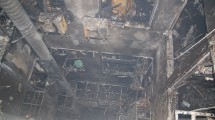Abstract
This study reported an actual building fire incidence for a ten-story building that occurred in Taiwan in 2008. Due to the stack effects the fire occurred on the third floor spread through the patio in a short time to the upper floors and caused three deaths in a tenth floor apartment. This study also attempted to reconstruct the actual fire scenario using computer simulation. The spread of the fire to the combustibles due to hot smoke was accounted for in the simulation. Variation of the fire scenario and the factors causing the fire spread were studied. It was found that an initial fire size below 1.0 MW would not generate sufficient hot smoke to cause fire spread despite the stack effects. However, any obstructions in the patio such as window shading has been found to cause heat accumulation that would aggravate the fire spread problem. The presence of a canopy at the top of the patio can cause higher concentration of smoke for the upper floors. The simulation results are found to be in good agreement with the actual incidence. Moreover the simulation results also show that when the fire spread through the patio the initial fire size of 1.0 MW at the fire site can grow to a building fire of 300 MW.
Similar content being viewed by others
References
Chow WK, Hung WY (2003). On the fire safety for internal voids in highrise buildings. Building and Environment, 38: 1317–1325.
Kerber S, Madrzykowski D (2007). Evaluating positive pressure ventilation in large structures: High-rise fire experiments. National Institute of Standards and Technology, NISTIR 7468.
Klote JH (1991). A General Routine for Analysis of Stack Effect, National Institute of Standards and Technology, NISTIR 4588.
Klote JH, Milke JA (2002). Principle of Smoke Management Systems, ASHRAE and SFPE.
Madrzykowski D, Kerber S, Kumar S, Panindre P (2010). Wind fire & high-rises. Mechanical Engineering Magazine, 2010(July):23–127.
Marshall NR (1986). Air entrainment into smoke and hot gases in open shafts. Fire Safety Journal, l0: 37–46.
NIST (2006). NIST Special Publication 1019, Fire Dynamics Simulation (Version 4)—User’s Guide, National Institute of Standards and Technology.
NIST (2008). NIST Special Publication 1017, User’s Guide for Smokeview Version 5—A Tool for Visualizing Fire Dynamics Simulation Data, National Institute of Standards and Technology.
Qin TX, Guo YC, Chan CK, Lau KS, Lin WY (2005). Numerical simulation of fire-induced flow through a stairwell. Building and Environment, 40: 183–194.
Taipei County Fire Department (2008). Investigation report for Linmut Residential Building Fire.
Zukoski E (1995). Review of Flows Driven by Natural Convection in Adiabatic Shafts, NIST-GCR-95-679.
Author information
Authors and Affiliations
Corresponding author
Rights and permissions
About this article
Cite this article
Shu, SB., Chuah, Y.K. & Lin, CJ. A study on the spread of fire caused by the stack effects of patio—A computer modeling and a reconstruction of a fire scenario. Build. Simul. 5, 169–178 (2012). https://doi.org/10.1007/s12273-012-0062-y
Received:
Revised:
Accepted:
Published:
Issue Date:
DOI: https://doi.org/10.1007/s12273-012-0062-y




